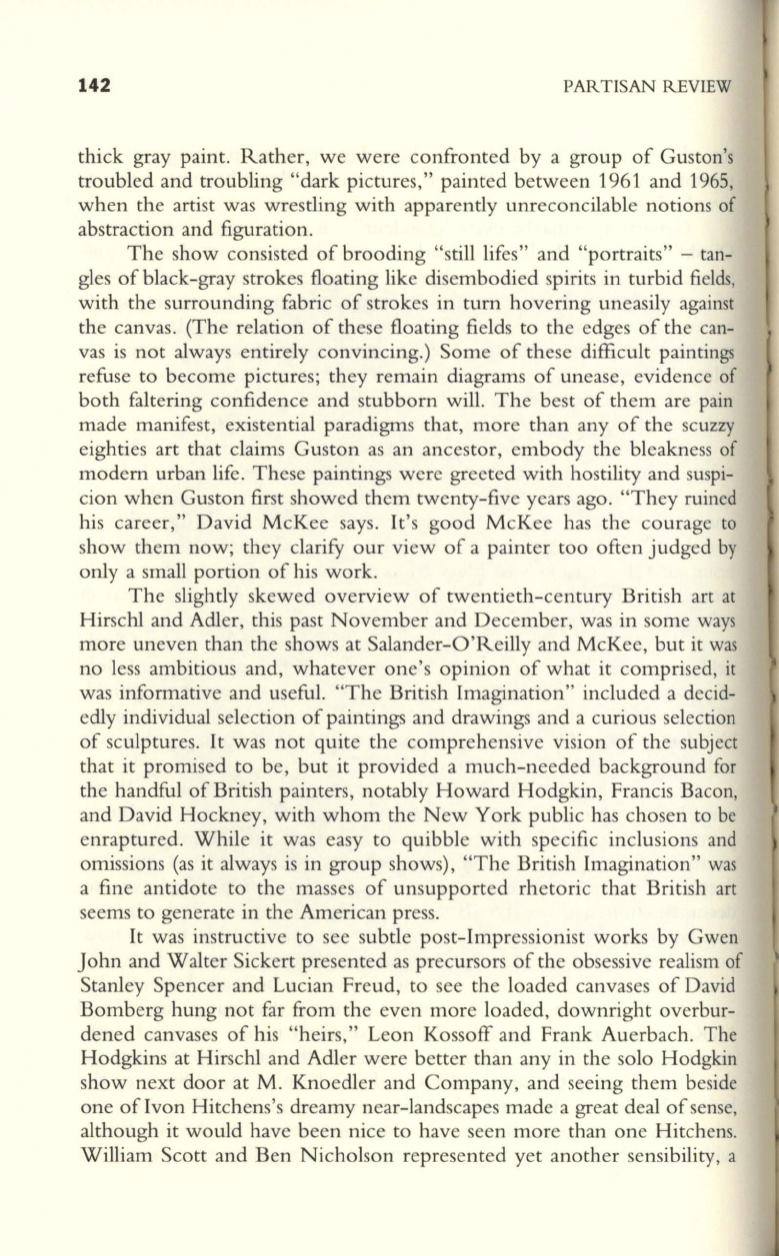
142
PARTISAN REVIEW
thick gray paint. Rather, we were confronted by a group of Guston's
troubled and troubling "dark pictures," painted between 1961 and 1965,
when the artist was wrestling with apparently unreconcilable notions of
abstraction and figuration.
The show consisted of brooding "still lifes" and "portraits" - tan–
gles of black-gray strokes floating like disembodied spirits in turbid fields,
with the surrounding fabric of strokes in turn hovering uneasily against
the canvas. (The relation of these floating fields to the edges of the can–
vas is not always entirely convincing.) Some of these difficult paintings
refuse to become pictures; they remain diagrams of unease, evidence of
both faltering confidence and stubborn will. The best of them are pain
made manifest, existential paradigms that, more than any of the scuzzy
eighties art that claims Guston as an ancestor, embody the bleakness of
modern urban life. These paintings were greeted with hostility and suspi–
cion when Guston first showed them twenty-five years ago. "They ruined
his career," David McKee says. It's good McKee has the courage to
show them now; they clarify our view of a painter too often judged by
only a small portion of his work.
The slightly skewed overview of twentieth-century British art at
Hirschl and Adler, this past November and December, was in some ways
more uneven than the shows at Salander-O'Reilly and McKee, but it was
no less ambitious and, whatever one's opinion of what it comprised, it
was informative and useful. "The British Imagination" included a decid–
edly individual selection of paintings and drawings and a curious selection
of sculptures. It was not quite the comprehensive vision of the subject
that it promised to be, but it provided a much-needed background for
the handful of British painters, notably Howard Hodgkin, Francis Bacon,
and David Hockney, with whom the New York public has chosen to be
enraptured. While it was easy to quibble with specific inclusions and
omissions (as it always is in group shows), "The British Imagination" was
a fine antidote to the masses of unsupported rhetoric that British art
seems to generate in the American press.
It was instructive to see subtle post-Impressionist works by Gwen
John and Walter Sickert presented as precursors of the obsessive realism of
Stanley Spencer and Lucian Freud, to see the loaded canvases of David
Bomberg hung not far from the even more loaded, downright overbur–
dened canvases of his "heirs," Leon Kossoff and Frank Auerbach. The
Hodgkins at Hirschl and Adler were better than any in the solo Hodgkin
show next door at M. Knoedler and Company, and seeing them beside
one of Ivon Hitchens's dreamy near-landscapes made a great deal of sense,
although it would have been nice to have seen more than one Hitchens.
William Scott and Ben Nicholson represented yet another sensibility, a


